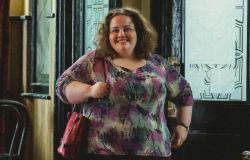Tatiana Elsoukova Literary promoter and writer
They have wrinkles and creases. They are fierce and tough. Middle-aged women are appearing on our screens more often, and I love it.
Published:
27 April 2024 at 13:18
Updated:
27 April 2024 at 13:18
You are now reading a chronicle. It expresses the submitter’s opinion.
“We’ve got one new heroine”, writes Bodil Skovgaard Nielsen in Klassekampen on 13 April. “Until recently, she hasn’t really been noticed that much. She is in the middle of life. And life has made her tough.”
As examples, she mentions both Kate Winslet in “Mare Of Easttown”, Sarah Lancashire in the British crime series “Happy Valley” and not least Jodie Foster in the last season of “True Detective”.
I do not think it is completely coincidental that Skovgaard Nielsen mentions crime series as examples. Crimea has long been the domain of men. Women have largely been reserved for the role of mute victims – dead beautiful girls in the background. The focus was on the often quirky and shy male detective, who was hunting a male murderer – a frightening but also fascinating figure.
In recent years, the somewhat lonely male investigator has given more and more space to skilled female detectives, who have both family and friends to deal with. They too can be strange and lonely, but they have both warmth, pity and humor with them.
Tatiana Elsoukova
Photo: Private
I love crime fiction and is excited about both “Mare Of Easttown”, “Happy Valley» and “True Detective: Night Country.” “Unforgotten” with Nicola Walker is another favourite. But there is one detective in particular that I have grown fond of: chief detective Vera Stanhope, played by Brenda Blethyn, in the British crime series “Vera”.
I melt a little every time she says “love” or “pet” when addressing a colleague or a witness. It is also extra funny when she says “pet”, a bit sarcastically, to an arrogant and suit-wearing, middle-aged man in a position of power.
Actress Brenda Blethyn plays Vera, who solves murder mysteries in Northumberland, a county in the northeast of England.
Photo: NRK
Vera can be both tough and strict, but she shows care where needed. In one episode, she stands and helps with the dishes, while she talks to a relative. In another, she finds a home for a homeless dog. In a third, she helps a refugee family obtain free legal aid.
At the same time, she is clear about her choice to live alone. She enjoys it and politely dismisses romantic approaches from her suitors: – I have no one to report to. I can do what I like when I want, she says. She loves her freedom.
About Pørni, ageing, shame and freedom
People feel free to call me witch, whore or bitch
In his chronicle has Skovgaard Nielsen dialogue with Lotte Hvas, a doctor who researches the menopause. Hvas has interviewed many well-grown women and says that several of them experience menopause as liberating. They are financially freer, have more time and are no longer so concerned with what men think of how they look.
According to Hvas, the well-grown woman often meets unrealistic expectations from those around her: “She must be sweet and kind. She has to keep the family together. She must be balanced. And make sure to write thank-you cards.”
No wonder menopause is seen as puberty number two, where the woman rebels against these expectations.
Kate Winslet as an investigator in the television series “Mare Of Easttown”. “The best thing that has happened to American crime series in a long time,” wrote Adresseavisen’s reviewer when the series came out in April 2021.
Photo: HBO NORDIC
The middle-aged the female characters from the crime series are far from sweet and kind. They fucking don’t write me thank you cards. When Vera and her colleague walk through a rowan forest, she is told that rowan was planted here to scare away witches. – Well, it hasn’t worked out so well, has it?, she says with a twinkle in her eye: – Here I am…
In the book “The Madwoman in the Attic”, one of the foremost works of feminist literary theory, Sandra M. Gilbert and Susan Gubar write about the two extreme images: the “angel” and the “monster”, in which authors of patriarchal texts placed their female characters.
The woman should preferably be like an angel: young, innocent and pious. On the other side was the monster, the witch: the unruly and self-absorbed woman who seduces, cooks rabbits, corrupts and destroys.
We find the angel and the monster in many stories. From Snow White and the Wicked Stepmother, to “Jane Eyre”, where Rochester’s crazy ex-wife is hidden away and locked in the attic.
The first season of “Killing Eve” premiered in 2018. Sandra Oh plays MI5 agent Eve Polastri in the series. She received a Golden Globe for her performance in this BAFTA TV award-winning spy series.
Photo: NICK WALL/HBO NORDIC
According to Gilbert and Gubar must the woman get rid of the constant angel-monster image created by the man/patriarch. She must search for her living, composite self.
Although Gilbert and Gubar studied authors of the eighteenth century, their theory also fits the crime genre. Crime literature was long filled with beautiful dead girls, Snow White in glass coffins: eternally young, robbed of their lives, but also aging. And then suddenly the aging female detective comes in, who doesn’t care much about being beautiful or sexy.
She is not there on the man’s terms. She has people to protect and murderers to catch. She is not the obedient, naive and self-sacrificing angel, but at the same time she is not the self-absorbed and destructive monster. She has broken out of that framework, she is much more.
Although the new ones the middle-aged heroines can be both tough and a little scary, they also have a lot of warmth and humor. Friendship and family relationships are central to these crime series.
In “Happy Valley” I like the friendship between the main character Catherine and her sister Clare. They stand together through thick and thin. And then they have such a wonderful sense of humor!
Sarah Lancashire plays the sober policewoman Catherine Cawood in the popular series “Happy Valley”.
Photo: BBC / NRK
For example, when Catherine has tried yoga and claims that it is dangerous: the whole class started farting massively after just a few exercises. – We released enough methane gas to melt the poles, she says. – Greta Thunberg had to come and have a chat with us.
Making friends with your aging body, farts, indigestion, hot flashes and night sweats included – and taking it all in with humour, is truly liberating!
Skovgaard Nielsen writes finally, that it is unfortunately mainly white women from the middle class who grace our screens. I agree. One has to look hard for representations of well-grown, melanin-rich and non-Western women, but they exist.
My favorites are Sandra Oh in “Killing Eve» and Viola Davis in “How to get away with murder”. But it is especially in Toni Morrison’s novels that I find women from all social strata: Women who are tough, and sometimes mean, but also generous and loving.
I hope that these women also find their way to our screens.
Join the debate! Send your text to [email protected]







